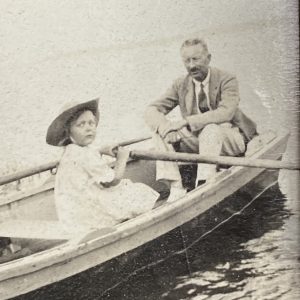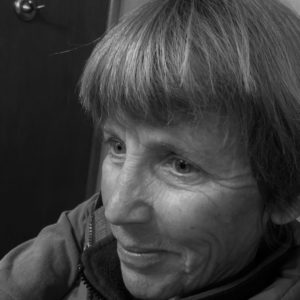 At the first sign of spring in my neighborhood, from the top of the street to the bottom, out come the boats. They sit on trailers or atop Subarus and SUVs. They lean against fences and languish in driveways. The street itself becomes an asphalt river, a runway for a beauty contest of boats.
At the first sign of spring in my neighborhood, from the top of the street to the bottom, out come the boats. They sit on trailers or atop Subarus and SUVs. They lean against fences and languish in driveways. The street itself becomes an asphalt river, a runway for a beauty contest of boats.
Brad, up the hill, is heading to the San Juan with a load of new Doryaks. He came up with the hybrid of dory and SportYak, chubby little wooden wonders, and people like them and ask for more. So he builds more and out they ride on their maiden voyage looking slightly uncomfortable on the trailer and eager to find the water. There they’ll settle in and tug on their bow lines and sway with the current as their ancestors have done for thousands of years. It’s in their DNA.
Boats are to this town what double-decker buses are to London, what cheesesteaks are to Philly. Iconic, they point to the very heart of the plateau, the deep heart that lies a few miles down the road: the canyon. The big one. The Grand one and its river that brought and now keeps so many of us here. We came to row boats or look at rocks or blow up the dam. We came and discovered friends, compatriots, fellow mischief-makers, all of us wanting to mess about in boats. And here we still are, no room in the garage because it’s been taken over by our kayaks and duckies, paddleboards and rafts. Neighbors John and Jo can’t even get into their driveway it’s so thick with dories.
I never worked on the Colorado as a boatman for pay, though I passed the test (sitting in a cruelly hot trailer up at Lees Ferry) and got my license. Boatman was what we all called ourselves, women included, before everyone switched to “guide.” But it’s never been about what you call yourself, has it? It’s all about what you do. I worked on the San Juan, taking young people down the river, a wonderful job until the fire ants came out at dusk and the dinner prep crew had to climb up on ammo cans in the kitchen to escape the stinging creatures. I worked science trips and learned how to sex mice and catch butterflies and dragonflies of extraordinary beauty. Those were lucky days—and long ones.
I was always happy to have a river in the background. Anyone can sleep beside the San Juan, but the Colorado’s a different story. A quiet stretch with the music of passing water—there’s nothing more soothing than that. But try and rest your head at a camp at the top of a rapid where the river shouts and the ground shakes, well, it takes practice.
I grew up between two rivers—the Hudson and East that wrap the island of Manhattan. My school was right next to the East River, and during our outdoor games of kickball it wasn’t uncommon for some girl with a mighty leg to send an India rubber ball over the fence and into the water below. We’d watch it dip and bob for a second or two then disappear downstream. And if my sister is to be believed, she saw a submarine rise from that same river right in front of her eyes as she sat daydreaming in math class.
That’s possibly apocryphal as most river stories are, or as a friend of mine likes to say, river stories are not often completely false, but always hyperbolic. This poses no problem on the river because, as Ratty might tell you in The Wind in the Willows, there’s always plenty of time and space around boats, and room for exaggeration.
The stirrings of spring start up then retreat in these early weeks of April, hot days to fool you followed by snow. But the boats know, and they begin their downhill slide past my house and on to the rivers. The snowpack from the Rocky Mountains is beginning to melt, the water beginning to rise. Down it comes, picking up speed on the steep mountainsides, tumbling into tributaries, side canyons, arroyos, anywhere it can find a foothold; carving its own way in places, and filling familiar canyons. A liquid migration of sorts, a pilgrimage, and a balm to the boats that await its arrival, cursing the clumsy trailers upon which they sit until suddenly a promise is fulfilled and the straps come off and the rising waters step up to hold them.
This year my boat, an old yet sound 16-foot Campways Shoshone, in its day a popular inflatable bucket boat (meaning it does not bail itself), will not be waking up and making its way to a river. Instead, it will curl up in the garage and await another season. The thwarts, the metal frame, the oars and bucket of oarlocks, the straps and lines and cooler pad—they’re all there and waiting too. They know how to wait. I don’t get on the water much anymore. But this time it’s a little harder to keep the whole show in bed in April. Every year it’s harder. Maybe because time is diminishing. Every summer not spent on a boat on a river is one less summer, and one less has a different resonance now.
So instead I close the crooked garage doors—they’re finally coming off their hinges, I make a mental note—and sit on my porch and watch other people driving their boats to water. There’s enough joy in this. The sight of wooden boats or rafts or kayaks or even a motorboat or two—it’s a good sight. The trailers are groaning. A few of them won’t make it up to the put-in without at least one flat tire. But spirits are high. The day is warm. The mountains east of here are melting and the upstream waters are filling and it’s all the beginning of a great run across the high desert and down down down to the sea. It’s just the way of things.

